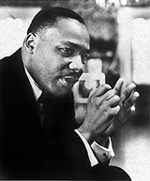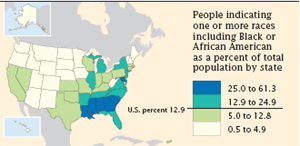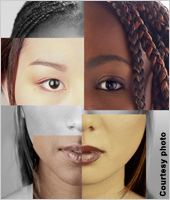Hintergrund
· African
American Experience
· African
American World
·
Africans
in America: America's Journey through Slavery
·
The
Amistad Revolt
·
Black
American Literature at Year 2000
·
Brown
vs. Board of Education: The Supreme Court Decision that Changed
a Nation
·
Civil
Rights: An Overview of Civil Rights & Related Supreme Court
Decisions in the U.S.
·
Civil
Rights Movement and the Legacy of Martin Luther King, Jr.
· Civil
Rights Timeline
·
Diversity
in the U.S.
·
The
Martin Luther King, Jr. Center for Nonviolent Social Change
·
Nation
Celebrates Anniversary Of Landmark Civil Rights Law
·
Nation feiert 40. Jahrestag
des Bürgerrechtsgesetzes
· National
Association for the Advancement of Colored People (NAACP)
· National
Urban League
· New
York Times > Topics > Race
· Our
Shared History. African-American Heritage
· Outline
of American History
· Portrait
of America
· Racial
Justice. ACLU
Originaldokumente
·
13th
Amendment to the U.S. Constitution: Abolition of Slavery (1865)
· 14th
Amendment to the U.S. Constitution: Civil Rights (1868)
· 15th
Amendment to the U.S. Constitution: Voting Rights (1870)
·
African-American
Texts Online
·
Basic
Readings in U.S. Democracy: On the Road from Slavery to Freedom
·
Brown
vs. Board of Education (1954)
·
Civil
Rights Act (1964)
· Emancipation
Proclamation (1863)
·
Famous Speeches
·
"I Have a Dream"
·
"Ich
habe einen Traum"
· Martin
Luther King, Jr. Speeches
· North
American Slave Narratives
· Official
Program for the March on Washington (1963)
· Say
it Plain. A century of African American Speeches
· Voting
Rights Act (1965)
· Voices
of Civil Rights
Multimedia
· Afircan
American History and Culture
· Being
a Black Man (Wash. Post)
· Ex-Slaves
Narratives
· History
Channel: King
· History
Channel: Voices of Civil Rights
· Malcolm
X Speaks on Race
·
Race: Are we so
different
· Say
It Plain. A Century of Great African American Speeches
· Underground
Railroad
Statistik
·
Black
Population in the United States
·
The
Black Population 2000
·
The
Black Population in the U.S.: March 2002
·
Facts
for Features *Special Edition* Civil Rights Act of 1964: 40th
Anniversary
·
Facts
for Features: African American Heritage Month, February 2010
·
Facts
on the Black/African American Population
·
Historical
Census Statistics On Population By Race, 1790 to 1990, and By
Hispanic Origin, 1970 to 1990
·
We
the People: Black Population in the United States
Ausstellungen
- Digitale Bilder
·
African-American
Mosaic: African-American Culture and History
·
Anacostia Museum
·
Exploring African
American Heritage
·
National
Civil Rights Museum
·
National Museum of African American
History and Culture
·
National Underground Railroad
Freedom Center
·
Powerful
Days in Black and White
·
Race: Are we so differen
· We
Shall Overcome: History Places of the Civil Rights Movement
Für
Schüler
· Civil
Rights in America
· Equality
Before the Law
· Martin
L. King Jr.. Interactive Classroom
· Meet
Amazing Americans: Frederick
Douglas, W.E.B.
du Bois, Duke
Ellington, Harriet
Tubman, Langston
Hughes
·
|
|
Unter
den Einwanderungsströmen nach Nordamerika befand sich eine Gruppe,
die nicht freiwillig kam. Es handelte sich um Afrikaner: 500.000 von
ihnen wurden zwischen 1619 und 1808 als Sklaven ins Land gebracht. 1808
wurde die Einfuhr von Sklaven in die USA illegal, aber Sklaven und ihre
Nachkommen zu besitzen hielt sich vor allem im landwirtschaftlichen
Süden, wo viele Arbeitskräfte auf den Feldern gebraucht wurden.
Der Prozess die Sklaverei abzuschaffen begann im April 1861 mit dem
Ausbruch des Amerikanischen Bürgerkrieges bzw. Sezessionskrieges
zwischen den 'freien Staaten' des Nordens und den 'Sklaven Staaten'
des Südens, die sich von der Union getrennt hatten. Am 1. Januar
1863, inmitten des Krieges, verabschiedete Präsident Abraham Lincoln
die Emanzipationserklärung, in der er alle Sklaven in den 'Rebellenstaaten'
für frei erklärte. Die Sklaverei wurde 1865 durch die Ratifizierung
des 13. Verfassungszusatzes in den gesamten Vereinigten Staaten abgeschafft.
Aber selbst nach dem Ende der Sklaverei wurden schwarze Amerikaner immer
noch durch Rassentrennung und schlechtere Bildung benachteiligt. Auf
der Suche nach neuen Chancen zog es immer mehr Afro-Amerikaner aus den
ländlichen Gebieten des Südens in die Stadtgebiete des Nordens,
so dass es zu einer inneramerikanischen Migrationswelle kam. Aber in
den Städten fanden viele Schwarze keine Arbeit, und sie mussten
getrennt leben von den Weißen; so entstanden in heruntergekommenen
Stadtteilen sogenannte Ghettos.
Ende der 50er und Anfang der 60er Jahre forderten Afro-Amerikaner unter
Führung von Dr. Martin Luther King mit Boykotts, Märschen
und gewaltfreien Protesten eine Gleichbehandlung nach dem Gesetz und
das Ende der Rassendiskriminierung.
Diese Bürgerrechtsbewegung erreichte ihren Höhepunkt am 28.
August 1963, als mehr als 200.000 Menschen aller Rassen sich vor dem
Lincoln Memorial in Washington, DC versammelten um Kings Rede zu hören:
" Ich habe einen Traum, dass eines Tages auf den roten Hügeln
von Georgia die Söhne früherer Sklaven und die Söhne
ehemaliger Sklavenhalter dazu fähig sein werden, sich gemeinsam
an den Tisch der Brüderlichkeit zu setzen. .... Ich träume,
dass meine vier kleinen Kinder eines Tages in einer Nation leben, in
der sie nicht nach ihrer Hautfarbe, sondern nach ihrem Charakter beurteilt
werden." Nicht lange danach verabschiedete
der U.S. Kongress Gesetze, die politische, rechtliche und soziale Rassendiskriminierung
verboten.
 |
| Photo
von Lloyd Wolf für das U.S. Census Bureau |
Heute
machen schwarze Amerikaner 13,5
% der Gesamtbevölkerung aus. In den letzten Jahrzehnten haben
Schwarze viel erreicht und immer mehr gehören nun der Mittelklasse
an. 2002 hatten 50,8
% aller schwarzen Amerikaner sogenannte "white collar"
Jobs - das sind akademische Berufe und Positionen im Management und
in der Verwaltung, im Gegensatz zu Dienstleistungsberufen oder solchen
die körperliche Arbeit verlangen. In Jahr 2003 waren 58,3 % aller
schwarzen High School Absolventen innerhalb eines Jahres an einem College
eingeschrieben (verglichen mit nur 35,8 % in 1982). Der Prozentsatz
der weißen Schüler, die nach dem Schulabschluss ein College
oder eine Universität besuchen, lag 2003 bei 66,1 %, also nur weniger
als 8 % höher. Das
mittlere Einkommen von Schwarzen ist allerdings immer noch niedriger
als das von Weißen, und die Arbeitslosigkeit - besonders unter
jungen Männern - ist höher. Und nach wie vor zwingt Armut
viele Afro-Amerikaner in Stadtteilen mit hoher Kriminalitätsrate
und Drogenmißbrauch zu leben.
In den letzten Jahren hat sich der Schwerpunkt der Bürgerrechtsbewegungen
verlagert. Heute sind Antidiskriminierungsgesetze in Kraft und immer
mehr Schwarze gehören zur Mittelklasse. Deshalb konzentriert man
sich auf die Frage, ob die amerikanische Regierung nicht angesichts
früherer Diskriminierung zu Wiedergutmachungs- beziehungsweise
Fördermaßnahmen, der sogenannten "Affirmative Action",
verpflichtet sei. Diese Maßnahmen können vorsehen, dass eine
bestimmter Prozentsatz von Arbeitsplätzen an Schwarze vergeben
werden muss oder dass eine bestimmte Anzahl von Schülern einer
Schule Angehörigen von Minderheiten sein müssen. Die öffentliche
Diskussion über die Notwendigkeit, Effektivität und Gerechtigkeit
solcher Programme verschärfte sich in den neunziger Jahren.
Die
vielleicht größte Veränderung in den letzten Jahrzehnten
jedoch ist die Einstellung der weißen Amerikaner. Mehr als eine
Generation ist herangewachsen seit King seine "Ich habe einen
Traum" Rede gehalten hat. Vor allem junge Amerikaner zeigen
einen neuen Respekt vor allem Rassen, und es gibt einen wachsende Akzeptanz
von Schwarzen in allen Bereichen des Lebens und des sozialen Umfeldes.
Siehe
auch:
About the USA > US-Geschichte >
Zeit des Umbruchs
About the USA > Feiertage > Martin
Luther King Day |
|
Identity
in America: Are Perspectives Shifting?
Multicultural, post-ethnic, post-racial. While these descriptors are
debated, most agree that with the possible exception of the American
Indian, to be American is to be, genealogically speaking, from somewhere
else. During February, America.gov is exploring how the ever-increasing
diversity of the U.S. ... (America.gov, 29 January 2009)
Landmark
Exhibit on Race Asks “Are We So Different?”
Is race real or a recent human invention? Is it about biology or culture?
These questions are addressed by RACE: Are We So Different?, a traveling
exhibit and related Web site on the history of the idea of race, the
science of human variation, and the experience of living with race and
racism. ... (America.gov, 28 January 2009) - "Race:
Are we so different" Web Site
Black
History Month Honors Legacy of Struggle and Triumph
John Fleming, head of black history study group, tells America.gov Black
History Month should focus on positive and negative aspects of the black
experience. “We were not slaves prior to being captured in Africa, and
while slavery was part of our experience … we have a hundred-and-some
years in freed ... (America.gov, 29 January 2009)
Americans
Celebrate Achievements of Martin Luther King Jr.
Americans on the third Monday of January honor the life and achievements
of the Reverend Martin Luther King Jr. (1929-1968), the 1964 Nobel Peace
laureate, a champion of universal justice, and the individual most associated
with the triumphs of the civil rights movement during the 1950s and
1960s. ... (America.gov, 14 January 2009)
"A
More Perfect Union"
In his first detailed discussion of race in America in this Philadelphia
speech on March 18, 2008, Obama expresses his “firm conviction” that,
in working together, Americans of all color can move beyond some of
the old racial wounds. He asserts that, in fact, Americans have no choice
if they are to c ... (America. gov, 11 January 2009)
U.S.
Minority Population Continues to Grow. By David Minckler
Slightly more than one-third of the population of the United States
-- 34 percent -- claims minority ,racial or ethnic heritage, a jump
of 11 percent from 2000.
The
May 1, 2008 Census Bureau report, covering estimates for the year
2007, confirms that the U.S. population is becoming increasingly diverse.
Hispanics and Asians continue to be the two fastest-growing minorities.
Blacks comprise the second-largest minority group, with 40.7 million
(13.5 percent), followed by Asians, with 15.2 million (5 percent). (America.gov,
May 14, 2008.) |
Beyond
Dr. King: More Stories of African-American Achievements
- A Living Book
Obama
in His Own Words (January
2009)
These pages share President Obama’s words with our global readership.
This book includes the complete text of the 44th President’s Inaugural
Address. Also featured are extended excerpts from eight other significant
campaign and pre-presidential speeches.
Barack
Obama: 44th President of the United States (January
2009.)
Barack Obama, elected the 44th President of the United States, has lived
a truly American life, and has opened a new chapter in American politics.
This publication tells the story of Obama’s life, describes how he captured
the presidency, and portrays his vision for the future.
FREE
AT LAST: The U.S. Civil Rights Movement. (February
2008.)
This publication tells the story of the African-American civil rights
movement in the United States, as well as of its roots in the historical
injustices of slavery and segregation.
Justice
for All: The Legacy of Thurgood Marshall. (January
2007.)
The name of Thurgood Marshall may not be as well-known outside the United
States as that of his fellow civil rights leader, Martin Luther King
Jr. And yet, Marshall's achievement in demolishing the legal structure
that sustained racial segregation in the American South advanced the
civil rights cause as profoundly as the nonviolent protests led by King.
|

 U.S.
Diplomatic Mission to Germany /Public
Affairs/ Information Resource Centers
U.S.
Diplomatic Mission to Germany /Public
Affairs/ Information Resource Centers 


